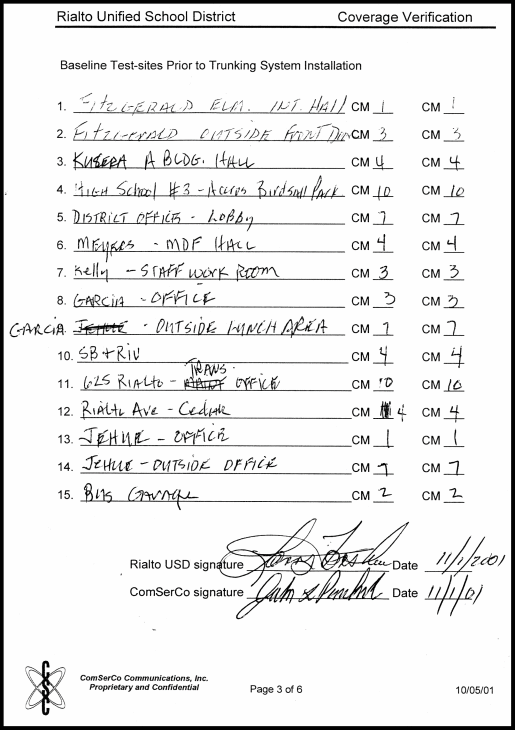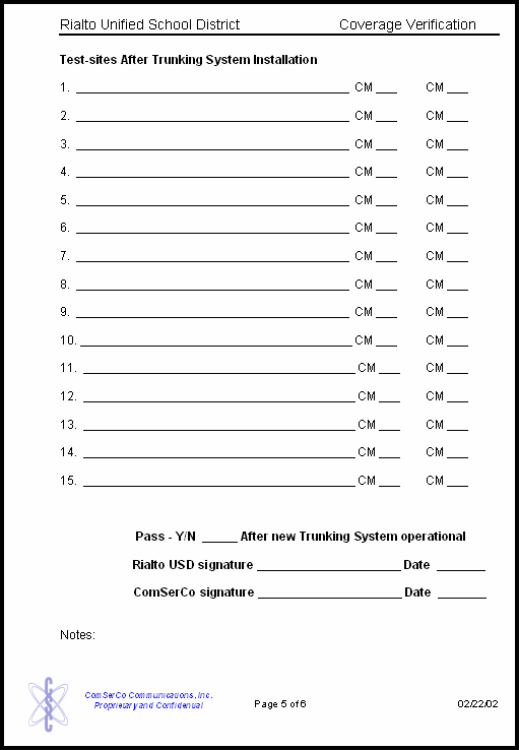

 |
Coverage Verification Procedure
The purpose of the Coverage Verification Procedure is to show that the new Trunking System has coverage as good as the existing 800 MHZ. single repeater. The Coverage Verification Procedure will establish one of the criteria’s for final acceptance for the operation of Rialto’s new Trunking System. Any re-testing of the baseline test locations will be allowed within a ten-foot radius of the original spot and any test locations must have a baseline of CM2 or better. The Coverage Verification Procedure will accomplish the following.
1. Establish a baseline
(Benchmark Coverage)
establish normal voice quality
at selected locations prior to beginning the integration of the new Trunking
System.
2. Verify baseline
after the new Trunking System is added
test coverage again at the
same selected locations after the new Trunking System has been installed.
Any activities that could affect coverage must remain static until the completion of the entire Coverage Verification Procedure. These include activities such as moving site antennas, installing or removing coverage enhancement devices, changing transmitter/receiver levels, etc.
Circuit Merit
The Coverage Verification
will be done on a Circuit Merit (CM) basis. CM is a subjective method of
measuring voice quality on a scale of 1 to 10. The CM level at each
location must be agreed on by both Rialto and ComSerCo. The representatives
must have normal hearing and the same individuals must agree on the CM
readings before and after the new Trunking System installation. The same
individuals will perform both tests. The Circuit Merit levels are
defined as follows...
- CM1 - Signal present less than half the time. Speech not perceptible.
- CM2 - Speech understandable only with considerable effort. Frequent Repetition required for intelligible conversation.
- CM3 - Speech understandable with slight effort. Occasional repetition Required for clarification.
- CM4 - Speech easily understandable. Some continuous noise.
- CM10 - Speech perfectly understandable. Negligible noise.
Test Locations
ComSerCo believes that CM
testing of around fifteen agreed upon locations would be the best approach
for signal quality measurements. The locations selected would take into
consideration the extremes of the antenna pattern and certain locations
where building penetration of the radio signal is required.
ComSerCo expects the new Trunking System to have identical or better radio
coverage compared to the existing 800 MHZ. repeater.
Establish a Baseline (Benchmark Coverage)
The purpose of the baseline test is to document the present coverage performance of the existing repeater. Before the new Trunking System is installed a CM test will be done to the selected locations. Dispatch will give two 10-counts on the existing single repeater. Both Rialto and ComSerCo must agree on the CM number. This test is to document existing system performance
Baseline Test-sites Prior to Trunking System Installation

Verify baseline after new Trunking System is installed
The purpose of re-testing the same locations is to show that coverage degradation has not occurred after the Trunking System has been installed. When the new Trunking System is connected the same CM test as previously performed will be done again. The same personnel including the same Dispatcher will be used.
Testing in exactly the same location is nearly impossible and RF coverage performance can vary with a distance of only inches. If a test point fails on the first try then 3 more tests shall be allowed within a 10 foot radius of the original spot until a CM level as good or better than the baseline is found. Failure of any one point, or points, will not constitute re-running the entire test at the locations already done. The test will continue and be completed. ComSerCo will remedy the issue and perform a test of only the failed point(s). A CM level equal or greater than the original baseline shall count as a pass.

This concludes the Coverage
Acceptance Test Plan.
